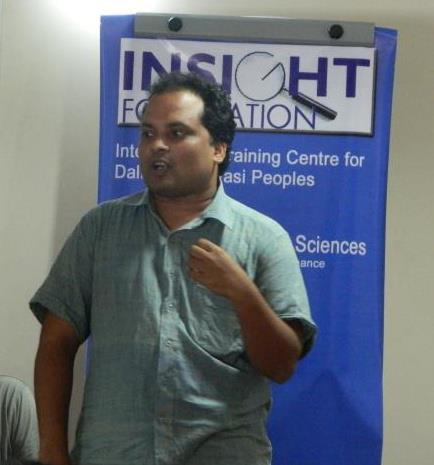Praveena Thaali
The recent debate on Arundhati Roy’s introduction to Annihilation of Caste: Annotated Critical Edition, published by Navayana, is quiet fascinating to look at, if viewed in a slightly different manner than usual. So, in this article, I will try to place some of my own observations.
First of all, I would like to point out that people who write /interpret/contextualize the Annihilation of Caste as theory and praxis should critically analyze the various discourses of caste as a reality in Indian society and they must think of annihilating it by acknowledging their own caste capital. In fact, while looking at Arundhati’s writing the first question that came to my mind was this: is it an introduction to Annihilation of Caste or to B.R Ambedkar? Secondly I wonder whether the writer is seeking any contextual popularity by iconizing Ambedkar in order to compare him with Gandhi? Third and most important question is: what must have led them to think about the necessity of an introduction like this? Finally, what are the factors that made Arundhati Roy write it?
In the present context, the dalits may be skeptical towards an intervention like this where the Annihilation of Caste and Ambedkar do not need a special introduction. It can be taken in two ways, one as a woman writing the introduction, another as a renowned literary figure-activist engaging in the same. However, this kind of interventions cannot be read without problematizing the background of the writer and the publisher. In another sense, it is surprising to note that Ambedkar and his text still needs a sympathetic introduction, even when dalits are affirming their self-respect through various forms like writings, protests and cultural activism with Ambedkar as a focal point.
Babasaheb’s work itself explains the articulation of one’s self respect in a caste ridden society, therefore it is really embarrassing that some of the publishers still believe that there is a need for elaborate ‘introductions’ (prefaces) to Ambedkar’s works and dalit writings to prove their authenticity. We see a similar process of ‘prefacing’ at work in the upper caste feminists’ collective introduction to the Intersections of Gender and Caste, the EPW issue on the Review of Women Studies, featuring the writings of various Dalit women (EPW: May 4, 2013). Similarly, they believe that, whatever knowledge is produced by dalits needs to have a cover/ framework/ flavor from the ‘authentic’ knowledge makers of the upper castes.
Though dalits are fully capable of articulating their subjectivity, Arundhati believes ‘history has been unkind to Ambedkar and that consequently his books are not shining in the bookshelves unlike Nehru’s and Gandhi’s’. In other words, Arundhati’s upper caste motherly sympathy operates to undertake a mission to deliver Ambedkar to the unreached, and to ‘fill the gap’ or ‘bridge the gap’. It is this messiah consciousness (as Anoop Kumar has observed) that made Arundhati take on an hegemonic saviour role with a mission of introducing AoC and Ambedkar to the Indians ‘schooled differently’. However, if she wants to ‘de-school’ Indians with her non-practicing caste ideology, shouldn’t she start with herself?
In fact, one has to ask the question, which Ambedkar has already raised, ‘think how much you are liberated before you liberate an untouchable’. If Arundhati wanted to approach the text to write an introduction with praxis, first of all she should have mentioned how to critically engage with her own community’s caste capital as well. Moreover, why does she still keep ‘Roy’ as a tail with her name, which must be giving her acceptance in the public domain (knowingly or unknowingly). It would have been much better for her to open up her critical engagement with caste by opening up towards her own community’s understandings of ‘Jati Nirmoolanam’ as a person who wrote about different inter-caste exchanges and engagements in her novel.
These are the reasons why I feel that Arundhati’s patronizing perception towards Annihilation of Caste and dalits is nothing but caste dominance.
Dalits, as a community are being humiliated by the bitterness of casteism and they have the right to be doubtful about the interference of upper caste reformers/liberators in their discourses, even if the latter have genuine intentions. Any reformer can be sympathetic to dalits and even to Ambedkar in order to patronize them. However, the politicized people know the history of publishing and circulation of Ambedkar’s Writing and Speeches all over India. The book Annihilation of Caste has been read by millions of people without any introduction by any upper caste messiah. Therefore, any reformist efforts, which advocates for the greatness of Ambedkar in the name of charity and loyalty have to be condemned.

The necessity of an introduction needs some further analysis. Does annihilation of caste really need an introduction, if yes, who needs it? The ‘Brahminical inscribed politics’ of the introduction clearly says that it focuses on a group that has not read Ambedkar yet, and that they may be ready to read if a person like Arundhati interprets it. Likewise, Arundhati also holds a kind of position with her writing to bring attention to AoC through her popularity. And it is obvious that, it provides a contextual popularity to the publisher for marketing also. This actually means that both writer and the publisher are ready to use the privilege of caste as a desirable thing in the present knowledge domain, so as to provide a wider market for the book in all terms.
Consequently, the “preface politics” deliberately sidelines the Annihilation of Caste, where Arundhati becomes the center point of all the discussions and thus links all this to the casteist hegemony over knowledge in India.
It is unfortunate that the people who are privileged by caste never talk about how they are engaged with it from their childhood itself, and instead they just want to interpret lower caste peoples’ experiences to declare their solidarity with them. Finally, if any one really still believes Annihilation of Caste and Ambedkar need an introduction, they are the real hypocrites and casteists who still demand an introduction to caste. Hence, it can be concluded that, the dominant knowledge arrogance inscribed in the attitude of the reformists has to be annihilated for the annihilation of caste.
~
Please also read other articles on the same issue:
A Glass Menagerie for the Bahujans—Annihilation of Caste and Gandhi’s Wards: by James Michael and Akshay Pathak
Stigmatizing Dalits, From the Wadas to the Web: by Nilesh Kumar
Without Arundhati Roy and Gandhi, the book had its own value: Bojja Tharakam
Caste in the Name of Christ: An angry note on the Syrian Christian Caste: by Nidhin Shobhana
The Not-So-Intimate Enemy: The Loss and Erasure of the Self Under Casteism: by Gee Imaan Semmalar
Flaunting noble intentions, nurturing caste privileges: by Asha Kowtal
The Question of Free Speech: by Vaibhav Wasnik
Arundhati Roy replies to Dalit Camera
An Open Letter to Ms. Arundhati Roy: by Dalit Camera
Vedic Chants for the 21st Century
Arundhati Roy’s ‘Introduction’ to Ambedkar: Inside one Misogynistic & Xenophobic Dalit’s mind: by Anoop Kumar
The Judge, the Jury and the Goddess: by Akshay Pathak
Resisting a messiah: by Anoop Kumar
An Introduction to Anoop Kumar’s “Misogynistic and Xenophobic Rants”: by Vinay Bhat
~~~
Praveena Thaali, doing Ph.D at Center for Human Rights, in University of Hyderabad.
Cartoon by Unnamati Syama Sundar.









